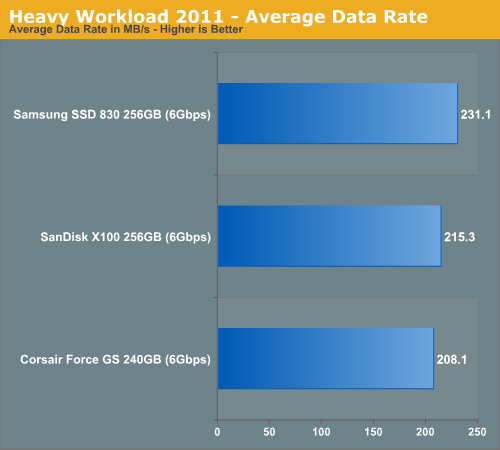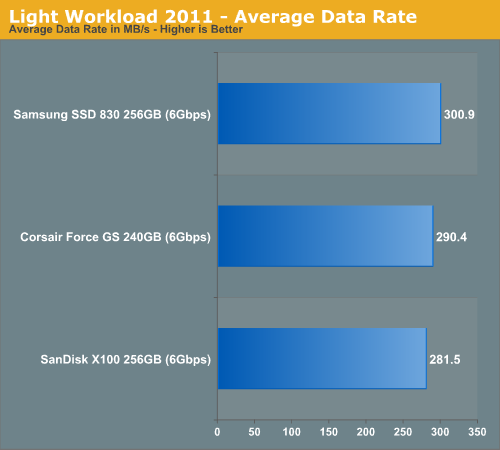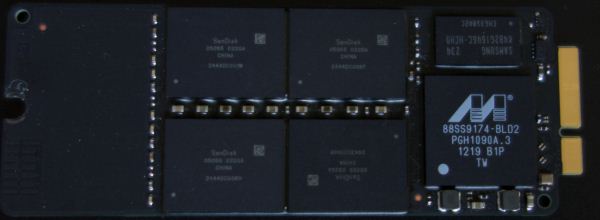Apple Is Now Using SanDisk SSDs in the Retina MacBook Pro As Well
by Kristian Vättö on February 5, 2013 11:48 AM EST- Posted in
- Storage
- Mac
- SSDs
- Marvell
- MacBook Pro
- MacBook Air
- SanDisk
- Retina
There has always been some level of lottery involved when buying an SSD-equipped Mac. The first Mac to start the lottery was the 2010 MacBook Air, which initially used Toshiba's SSDs but later it was found that some units were shipping Samsung SSD 470 based drives. Up until last year Apple kept using the same Toshiba and Samsung SSDs; the 2012 refresh finally brought SATA 6Gbps SSDs to Macs and, of course, another round of lottery too. The 2012 MacBook Air kept using drives from both Toshiba and Samsung, albeit both were newer generation (Toshiba's is SF-2281 based, Samsung is PM830). The rMBP, however, used only SSDs from Samsung, and the 256GB and 512GB SSDs in the MacBook Air were all Samsung made as well.
Late last year it was discovered that some rMBPs might be using SSDs from SanDisk. At that time we only had system profiler screenshots and user reports to go with, which I didn't think was enough to go by (after all, the controller is the most interesting part of the story anyway). Today, I have some pictures to show:
Courtesy of MacRumors forum user Artagra
In short, that's a custom version of SanDisk's X100 mSATA SSD. The controller is Marvell's 88SS9174, which is also used in Crucial m4, Intel SSD 510, and Plextor M5S, each with custom firmware. That's coupled by eight (four on each side of the PCB) 24nm Toggle-Mode MLC NAND packages from SanDisk (SanDisk has a NAND joint-operation with Toshiba). Anand actually has an X100 in the house and just finished running tests on it a few days ago, so here's a brief comparison of the SSDs used in Macs at the moment (Corsair Force GS is the closest match to the Toshiba SSD):


Note that these are all retail drives; the drives Apple is using are custom and hence the performance may be slightly different (customized firmware). The X100 in the graphs is actually a newer 88SS9175 based X100 (it might be X110 as SanDisk wasn't very specific) so performance of the 9174 based might be slightly different (we shouldn't be anywhere close to U100 speeds, fortunately). The 9175 is essentially just a low-power version of the 9174 with only four channels, so I wouldn't be surprised if the 9174 based X100 was even faster. However, all the drives Apple uses are good performers. The SSD 830 is the fastest of them all but the X100 and Toshiba are trading blows as you can see above.
I'm not surprised by Apple's move. Apple is constantly buying more and more SSDs (and flash in general) and relying on just one supplier is risky. If one manufacturer has a hiccup in production, Apple still has the channel to quickly buy SSDs from another manufacturer. There's also a possibility that the availability of Samsung PM830 is decreasing because it's now a discontinued product. Samsung told me they still have plenty of stock for OEM and B2B customers but the volume Apple needs is fairly significant and Samsung may not be able to supply that anymore. Samsung does have a newer SSD 840 (Pro) available but it's possible that Samsung's pricing made Apple choose SanDisk.
Either way, SanDisk is now the third OEM to supply SSDs to Apple. I've only seen the X100 appear in the rMBPs so far but it's certainly possible that we will see SanDisk SSDs in other Macs (such as the Air) too. While I'm sure most of the buyers would prefer the Samsung SSD (including myself), the good news is that none of the drives Apple is using are exceptionally bad. Unless your workload is very IO intensive, there shouldn't be a significant difference in real world performance (except when dealing with incompressible data and the Toshiba drive).
Thanks Paul for giving us the permission to use your picture!












31 Comments
View All Comments
orthorim - Wednesday, May 1, 2013 - link
If you wanted to make a point about your ignorance - congratulations, you win.FWIW I do care about having 2800x1880 pixels on my 15" screen. It comes with some perks that are pretty unique:
- No pixels visible. Ever.
- Photos look better than on any other display - you see way more details. Previously my iPhone 5 camera pix looked pretty good; turns out a lot of that was due to the low res display. Watching it on the retina there's a HUGE gap to modern DSLRs. It's like night and day. Camera limitations become glaringly obvious.
- Scaling carries no penalty in sharpness. Whether I run at 1680x or 1920x1200 - both scaled - there are no pixels visible. So I can choose from a variety of screen resolutions. That's not the case on a lower res display - those you can either run at native resolution, or it looks like shit.
- Screen is so sharp that 1920x1200 is a perfectly acceptable resolution on 15". Admittedly thats only the case with the Samsung LCD panels, the LG ones are more blurry.
maratus - Wednesday, February 6, 2013 - link
That's not raw performance I'm talking about when I said there're no rivals. I can always buy a well-specced Clevo for a lot less, but I don't need it. I prefer to have 95Wh battery and hi-resolution IPS screen in a slim and low-weight form factor instead while retaining most of the performance. And I'm willing to pay premium price and deal with other compromises, too.Of course, you can buy a faster laptop, but you need a serious DTR for that, and the biggest difference will be mainly in discrete GPU. I don't think that having more than one 2.5" is beneficial (although I'd prefer a regular form factor in rMBP) as I'm totally against RAID0 in this case. I don't want mechanical drive inside the laptop either, so it's a moot point. You won't have significantly faster CPU and not everyone absolutely needs 32Gb of RAM in a laptop!
orthorim - Wednesday, May 1, 2013 - link
Don't forget to mention build quality. I crashed my motorbike; the retina MacBook Pro sliced through two thick bags, impacted on the concrete, and got a small ding on the corner. The laptop still works perfectly. Apart from the aluminum abrasion, it looks perfect too. In a similar situation the Clevo would shatter in a thousand pieces...Anyway if you'd told me a year ago I'd have a retina laptop with core i7, 7 hours of battery, and 2kg I'd have laughed.
Arbee - Wednesday, February 6, 2013 - link
And a trackpad that doesn't suck. PC makers almost uniformly ship terrible screens and worse trackpads, but you've heard that rant on the AT podcast several times :)KPOM - Tuesday, February 5, 2013 - link
I'm guessing you've never frequented the MacRumors forums where people obsess over whether they get an LG vs. Samsung screen, or Toshiba vs. Samsung (and now SanDisk) SSD.Zak - Wednesday, February 6, 2013 - link
Perhaps not, but Mac users might care.phillyry - Sunday, February 24, 2013 - link
I returned my 128GB MBA and was gleeful when I saw that I got a Samsung in the 256GB model.Btw, Anand (as well as pretty much every tech writer at theverge) uses a MacBook. It's commonplace in the industry.
You can be smart, well informed, and enjoy your PC experience, whether it's Windows or Mac. Honestly, the Mac is way more enjoyable but the PC is nicer for managing files.
orthorim - Wednesday, May 1, 2013 - link
Three kinds of people are both technically knowledgeable and use PCs:- Gamers
- IT folks that work in corporate IT which is all Windows
- Programmers who work on stuff that only runs on Windows (of which there's less and less)
All the good developers I know have been on Macs for years and years...
orthorim - Wednesday, May 1, 2013 - link
Ummm.... yes we do?!Oyinko - Thursday, February 28, 2013 - link
It seems the new sandisk cause some issues with the fans of the Macbook Pro Retina. Check the topic on Apple Website. https://discussions.apple.com/message/21387016